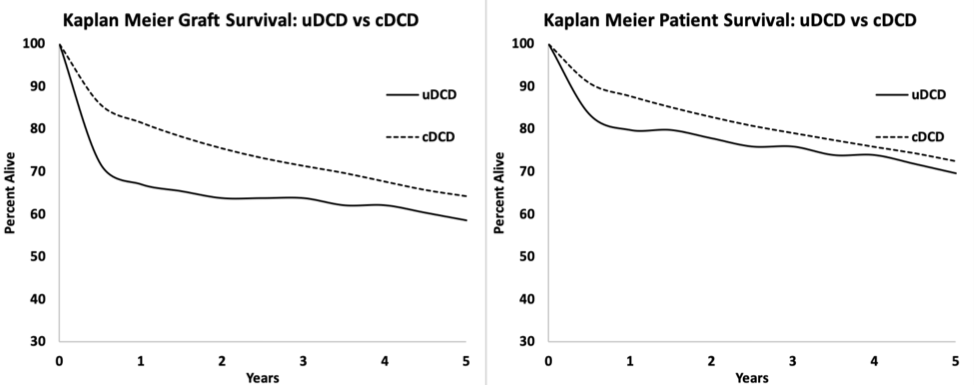Long Term Outcomes Following Uncontrolled and Controlled Donation after Cardiac Death Liver Transplantation in the United States
1Department of Surgery- Division of Transplantation Surgery, University of Colorado Hospital, Aurora, CO, 2Thomas Jefferson University Hospital, Philadelphia, PA
Meeting: 2020 American Transplant Congress
Abstract number: A-126
Keywords: Donors, marginal, Graft survival, Liver transplantation, Mortality
Session Information
Session Name: Poster Session A: Liver: MELD, Allocation and Donor Issues (DCD/ECD)
Session Type: Poster Session
Date: Saturday, May 30, 2020
Session Time: 3:15pm-4:00pm
 Presentation Time: 3:30pm-4:00pm
Presentation Time: 3:30pm-4:00pm
Location: Virtual
*Purpose: Poor short-term outcomes following uncontrolled donation after cardiac death (uDCD) liver transplantation has led to near non-utilization of such donor allografts in the modern era. However, after the initial post-operative period, the durability of uDCD allografts remains unclear in comparison to controlled DCD (cDCD) liver allografts. As such the aim of this study was to compare the long-term outcomes following uDCD and cDCD liver transplantation in the United States.
*Methods: All adult DCD liver transplants performed between March 2002 and December 2017 in the OPTN/UNOS database were analyzed. Retrospective cohorts included the following patient groups: uDCD, and cDCD liver transplant recipients. Kaplan-Meier method was used to analyze graft and patient survival. Cox regression models were utilized to describe adjusted effects of donor/recipient covariates.
*Results: There were 66 uDCD and 4,679 cDCD liver transplants performed during the study period. Although, one year graft (67.0% [uDCD] vs. 81.6% [cDCD], P<0.01) and patient survival (79.9% [uDCD] vs. 87.7% [cDCD], P<0.01), was inferior following uDCD transplantation, adjusted long-term graft failure (aHR=1.22, 95% CI= 0.87 - 1.71, P=0.24) and mortality (aHR=1.05, 95% CI= 0.71 - 1.57, P=0.77) was not different between the uDCD and cDCD cohorts.
*Conclusions: Short term outcomes following uDCD liver transplantation are inferior in comparison to cDCD. However, after one year following transplantation, graft and patient survival trends are comparable. It remains unclear which uDCD allografts offer utility and which are associated with high risk for recipients. As such, strict and conservative donor and allograft selection criteria should be applied for any potential uDCD liver allograft.
To cite this abstract in AMA style:
Choudhury RA, Yoeli D, Yaffe H, Moore HB, Hoeltzel G, Schulick A, Conzen KD, Pomposelli JJ, Pomfret EA, Nydam TL. Long Term Outcomes Following Uncontrolled and Controlled Donation after Cardiac Death Liver Transplantation in the United States [abstract]. Am J Transplant. 2020; 20 (suppl 3). https://atcmeetingabstracts.com/abstract/long-term-outcomes-following-uncontrolled-and-controlled-donation-after-cardiac-death-liver-transplantation-in-the-united-states/. Accessed December 23, 2025.« Back to 2020 American Transplant Congress

